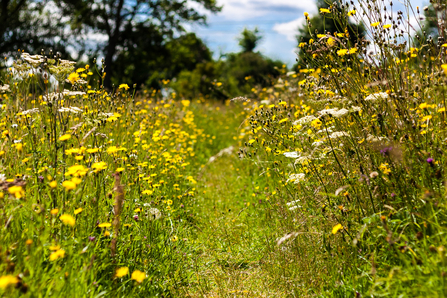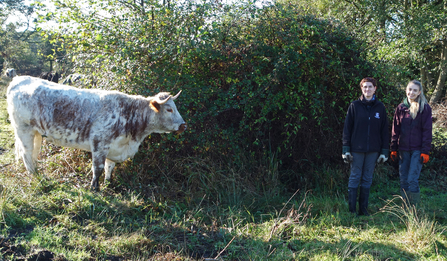One of my first tasks as a trainee was mowing a meadow. Since then I’ve learnt lots about other tasks that are necessary to maintain the biodiversity of grassland habitats and would love to share them with you.
One trainee went to mow...
Brush-cutting by Iain Turbin

Eades Meadow by Paul Lane
There are different types of grassland, defined as calcareous (found on shallow lime-rich soils), acidic (found on sands and gravels) or neutral (found on clay and loam soils). Meadows are enclosed grasslands where hay crop is taken in summer and pasture is usually grazed.
Unfortunately, grasslands are vulnerable to disturbance and most have been significantly degraded by development and agricultural intensification (fertilisers, herbicides, ploughing and overgrazing). Consequently, 97% of species-rich lowland meadows across England have been lost since the 1940s. Lowland unimproved grassland meadows are designated as a priority habitat for restoration in the UK and are listed as a habitat of European significance. Sadly, numbers of butterflies and breeding birds, including curlews and lapwings, are continuing to decline. Worcestershire is an important county for grasslands, containing a fifth of England’s remaining flower-rich meadows and pastures. Our Trust owns and manages more than 30 meadows, so it is a habitat I have become quite familiar with!

Snake's-head fritillary by Tom Marshall
Grasslands are valuable habitats that provide countless benefits for us through natural processes, including floodwater storage as well as vital sources of nectar for pollinating insects. Across the UK, grasslands store two billion tonnes of carbon in their soils. Grasslands that haven’t been fertilised, drained or reseeded (unimproved) support rare and beautiful species including orchids, waxcap fungi, blue butterflies, and nesting birds. Imagine a summer's day when wildflower-rich meadows are bursting with colour, the buzzing of bees and the calls of the curlew. They're also home to one of my favourite flowers, the purple chequered snakes-head fritillary, which blooms in spring, which is only found in a handful of floodplain meadows in England (sadly, not here in Worcestershire).
Now that know how great grasslands are, let’s move onto the management and how we can enhance these degraded habitats to benefit nature!
It is important to preserve traditional management techniques, which include the main methods of grazing with traditional breeds and cutting hay at the right time of year to ensure a rich wildflower sward remains. All grasslands need to be managed to prevent them becoming scrub or woodland and to prevent the domination of tall and vigorous grasses that outcompete less vigorous species and reduce biodiversity.

Meeting an English longhorn by Iain Turbin
Livestock remove plant growth and create bare ground by grazing and compacting the soil, which creates opportunities for seeds to germinate and generates a varied grassland structure that benefits insects and breeding birds. With livestock grazing comes the need for fences and, in turn, fence repairs. This is one of the tasks necessary for maintaining nature reserves. The first time I repaired fencing was at Pound Green Common a couple of months ago. I was introduced to a post driver: a heavy-duty piece of equipment used to hammer fence posts into the ground. As Lydia emphasised in her previous blog, it is so important to wear a safety helmet when using one of these – you wouldn’t want to accidentally knock yourself on the head! Something I found particularly challenging was hammering staples to fix the metal wire onto the fence posts, especially when they didn’t go the direction I wanted them to. Thankfully, I think my practical skills have improved since then.
Volunteers raking a meadow by Iain Turbin
The first few weeks of my traineeship involved a lot of mowing so I became quite accustomed to using the mowers, which were quite intimidating at first as they have a clutch and multiple gears. I enjoy this task as it usually involves a team effort because some meadows are huge and it would be such a mammoth task without the help of our volunteers. Mowing is an efficient way of removing a large amount of biomass, allowing more vulnerable plants to grow. Raking the grass and creating distinctive habitat piles at the edge of a site is a crucial part of the process. If the grass is not removed, it can smother delicate plants and increase soil fertility, which favours the growth of more vigorous plant species at the expense of wildflowers.
Windmill Hill by Wendy Carter
Scrub management can also be done using brush-cutters, especially when brambles are involved because these can easily get caught up in the wheels of a mower, making mowing more difficult. After completing my brush-cutter training back in November, I visited Windmill Hill and did some brush-cutting to remove some of the brambles that were beginning to take over in some areas. Although bramble does provide valuable protection for nesting birds, habitat for small mammals and food sources for insects, birds and mammals, it is important to maintain a balance of open and scrub habitat to increase the diversity of habitats available. As well as offering brilliant views of the Avon Valley, Windmill Hill is one of the best remaining limestone grasslands in the county, supporting a rich community of plants, including field scabious, common-spotted orchid and bird’s-foot trefoil, so it is vital that we strive to conserve the valuable grassland habitat.
The management of grasslands is a more complex process than I expected, with the timing and frequency of grazing and mowing heavily influencing which species will thrive on a site. It is also crucial to avoid disturbing nesting birds during the breeding season by timing cuts around this as well as keeping dogs on leads and away from certain areas of a site. Careful planning is required and management can be adapted to suit individual sites, depending on the requirements of priority plant species present and when plants flower in the year. I have gained so much more appreciation for wildflower meadows after learning how much hard work goes into conserving them!

